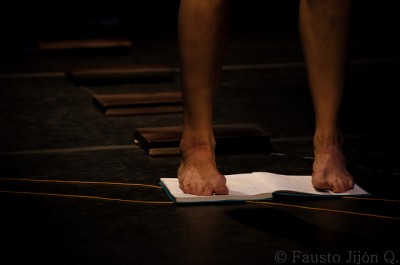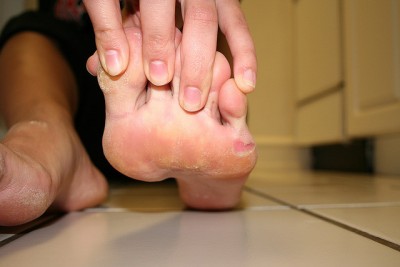Dancing barefoot is a calling card of modern dance training and has often been the footwear of choice for contemporary dancers on stage and in the studio, regardless of their training. (If they’re not wearing socks, that is.)
Modern dance founders chose to dance in bare feet because it reflected core values like connection to the body and representation of Earthly or human ideas and emotions. Barefoot dancing distinguished modern dance from ballet. It was also a defiant act during an era when it was scandalous for a woman to show even her ankles, let alone her naked feet.

Danzanet (Choreographer: Vivían Cruz) used by permission.
Dancing barefoot isn’t exactly rebellious anymore but anyone that’s ever danced barefoot knows it still comes with risks. I mean, you think ballet dancers have it bad?
…well, they do.
But cracks, splits and fungi are no fun either!
So, if you are a barefoot dancer (or plan to be), here are some tips to help you care for your fantastically unadorned feet.
Callus Care
They aren’t pretty but, as long as they are not painfully thick or too dry, calluses for a barefoot dancer are actually a good thing. They help you turn and slide, yet really feel the floor beneath your feet. If they are mostly even with the surrounding skin, you can leave your calluses (which take a long time to build) alone. Use a pumice stone to shave them down if they start getting too big. Just be careful not to file too far. Soaking feet in Epsom salt, or using vaseline overnight can also help to keep the callus pliable and less likely to crack. If a callus does crack, care is similar to that of our next common barefoot dance concern.
Splitsville
The splits are ordinarily something dancers love (or love to talk about, anyway) but skin splits between or beneath your toes are the pits! Speaking from experience, there’s nothing more painful or annoying (think: dancing on a paper cut).
Splitting skin in and around the toes is difficult to bandage. Therefore, splits often tend to reopen and can deepen, or worse, become infected. For this reason, it’s best to do all you can to avoid this nastiness and prevent skin splits from happening in the first place. Again, a nighttime moisturizing routine can help greatly here, as can keeping your body well-hydrated. Also take care to keep your feet clean and dry.
If you are already experiencing a split, my condolences. Be sure the tear and surrounding skin is clean. Then, try to place a bandage (or half of one) across the split like a bridge. Use medical tape to hold the bandage in place on the top and on the bottom of your foot, if necessary. At minimum, change any bandaging daily. It is usually a good idea to wear some kind of foot covering (dance paws or socks) until the split is fully healed.
Some dancers use liquid bandage on splits. You may want to make sure there are no young children around when you try this as dancers have been known to utter obsenities during its application. This one stings, kids. You still need to keep the wound covered if you plan to keep dancing because liquid bandage is not a lasting fix.

Blisters
Blisters are a bit more common among ballet dancers but I’ve seen modern dancers form big blisters under the ball of the foot. Our contributor, Lauren Warnecke covered blister treatment and more foot maintenance tips in part one of her Meet Your Feet series, so I won’t rehash it all here.
The F-word (Fungus) and Infections
The dance studio floor is rarely the most sanitary of surfaces. Athlete’s foot isn’t just found in locker rooms and plantar warts are a viral infection. These contagious conditions can be aggravating, painful or cause other problems for dancers.
Some dance studios opt for a shoes and socks-only environment but there are many benefits of barefoot dancing for children and adults. Lucy Vurucic Riner describes why she loves dancing barefoot at 4dancers, and personally, as someone who has danced barefoot from a young age, I have to agree.
If you are a fervent bare feet fan, take heart. Fungal or infection outbreak among dancers can be avoided if dancers practice good hygiene. I’ve personally never experienced an outbreak in any dance program or studio. But learn to recognize symptoms and get treatment as soon as an issue is suspected. Don’t treat fungus and infections like dirty secrets.
Oh, Burn!
Floorwork too, has been a notable characteristic of modern dance throughout the decades. As contemporary dance requires increasing levels of athleticism, scrapes and burns on the ankles and feet of barefoot dancers become more common. So common, dancers may not think much about caring for these rather tame (though painful) injuries. It’s worth noting that even abrasions like floor burn should be treated with a topical ointment like Neosporin and covered with a bandage to reduce chance for infection and bacteria growth. You can relieve a painful floor burn by running cold water over the wound, but don’t use ice or lotions as these can make it worse.
Plantar Fasciitis
Plantar fascia is connective tissue that begins at your heel and extends to the base of your toes. It supports the arch of your foot. It’s constantly being used in movement of the feet. Because barefoot dancers lack arch support, they are prone to an overuse injury called plantar fasciitis that usually causes pain along the arch or on the inside of the heel.
As with most overuse injuries, treatment involves rest, applying ice, stretching, massage, and anti-inflammatory medications. You’ll want to catch and treat it early for an easier recovery.
As for prevention, be aware of and correct any tendencies to pronate the feet. Work to build strong feet. Wear shoes with good arch support or night splints when you aren’t dancing, and look into taping methods or arch band supports
when you are. Plantar fasciitis can become a chronic problem. Don’t hesitate to see a qualified podiatrist to help you find the right solution.
Try a Little Tenderness
There’s no doubt barefoot dancers are hard on their feet. Make sure you give your feet some tender, loving care on a regular basis. Here are three ways to do that:
- Practice good technique with proper foot and ankle alignment.
- Spend some time with your feet daily to look for any potential problems — a great way to check in is with a daily foot massage. Use your hands, pinky balls
, or ask your friend/partner.
- Pamper your feet by soaking them in a foot bath — especially if your feet are tired or sore — and by applying moisture treatments like petroleum jelly, lanolin-based cremes, or your favorite lotions.
What are your favorite ways to care for modern dance feet?
What do you love (or hate) about dancing barefoot?
Tell us in the comments!
Nichelle Suzanne is a writer specializing in dance and online content. She is also a dance instructor with over 20 years experience teaching in dance studios, community programs, and colleges. She began Dance Advantage in 2008, equipped with a passion for movement education and an intuitive sense that a blog could bring dancers together. As a Houston-based dance writer, Nichelle covers dance performance for Dance Source Houston, Arts+Culture Texas, and other publications. She is a leader in social media within the dance community and has presented on blogging for dance organizations, including Dance/USA. Nichelle provides web consulting and writing services for dancers, dance schools and studios, and those beyond the dance world. Read Nichelle’s posts.

